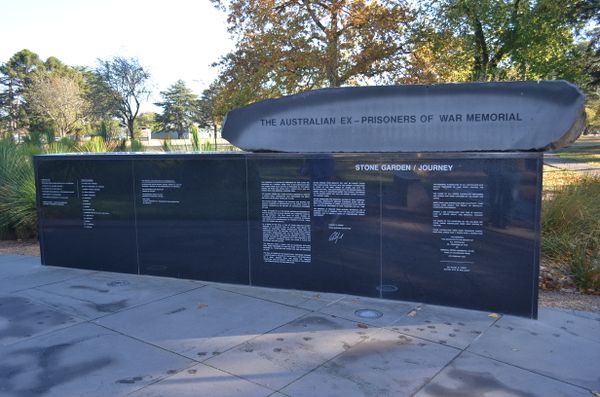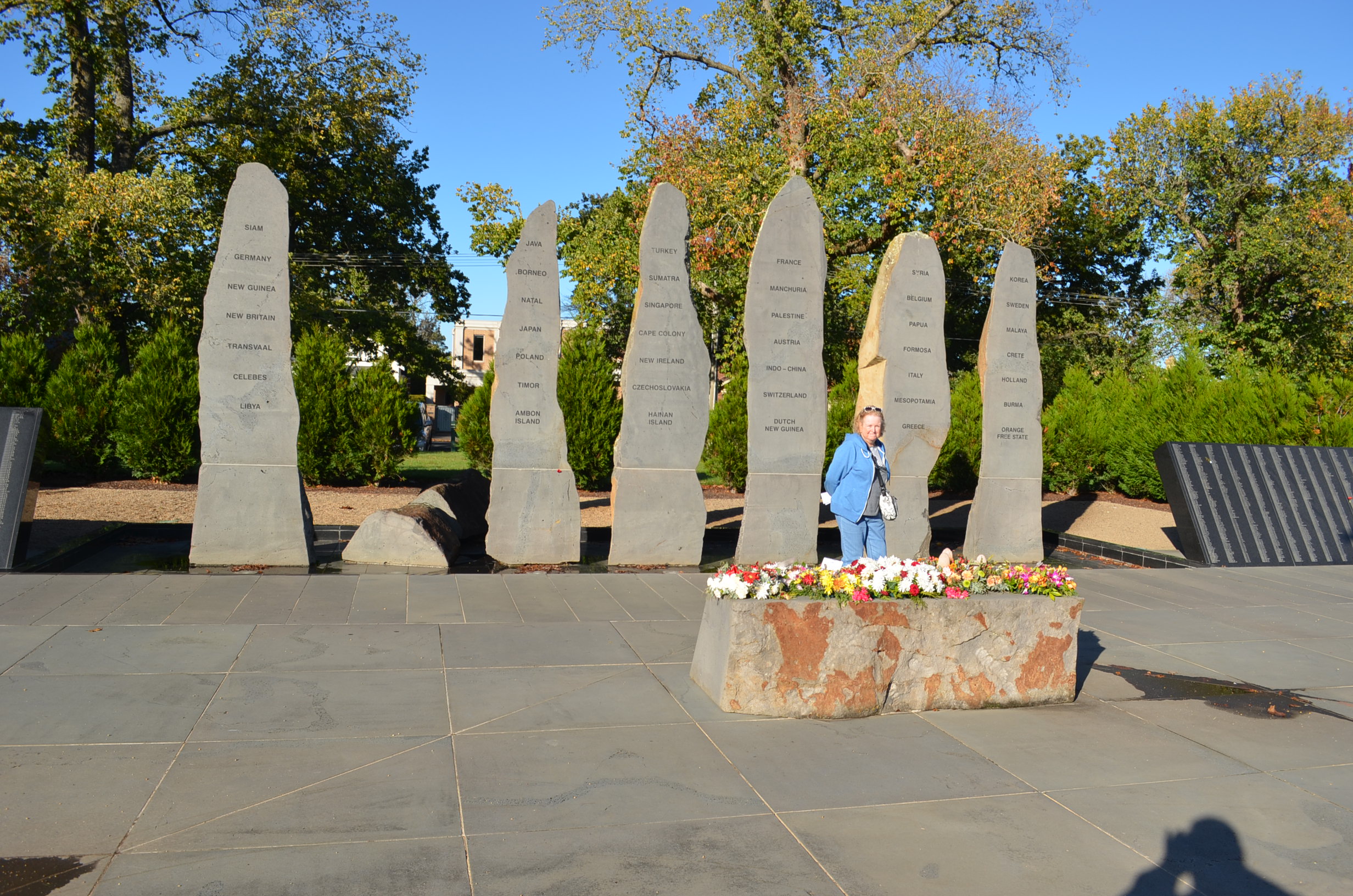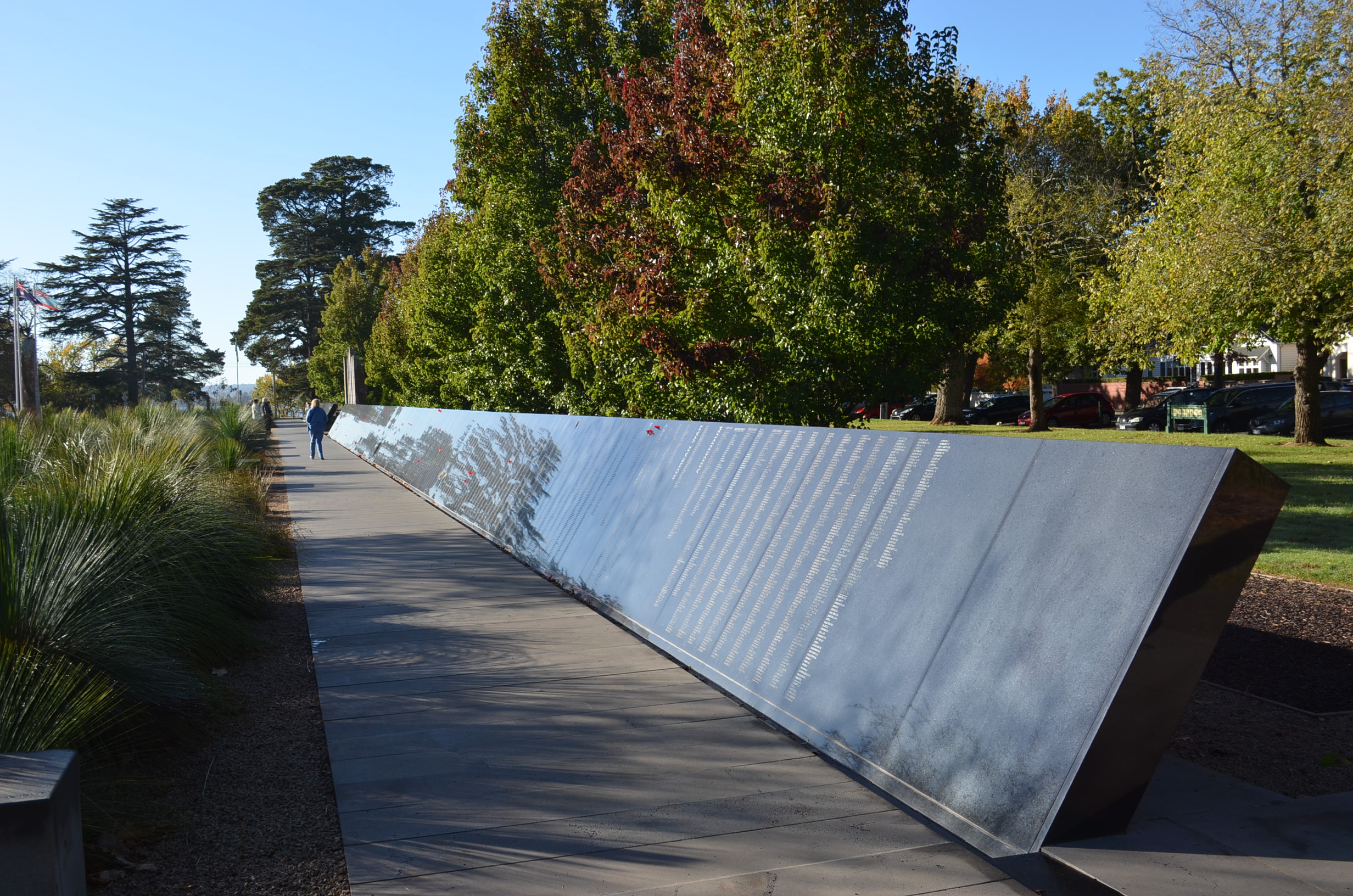Difference between revisions of "The Australian Ex-Prisoners of War Memorial"
From Our Contribution
(→World War II 1939 - 1945) |
(→World War II 1939 - 1945) |
||
| (19 intermediate revisions by the same user not shown) | |||
| Line 1: | Line 1: | ||
{{Infobox | {{Infobox | ||
| − | | name = | + | | name = The Australian Ex-Prisoners of War Memorial |
| title = | | title = | ||
| Line 20: | Line 20: | ||
| label2 = Name | | label2 = Name | ||
| − | | data2 = | + | | data2 = The Australian Ex-Prisoners of War Memorial |
| label3 = Location | | label3 = Location | ||
| Line 34: | Line 34: | ||
}} | }} | ||
| − | == | + | |
| − | + | ==Background== | |
| + | |||
| + | History | ||
| + | Between the 1950s and 1990s surviving prisoners of war from the Ballarat region met regularly and the idea of a focal point for commemoration were periodically discussed. Mewanwhile the Australian Federal Government had given periodic undertakings that a permanent monument would be eventually built in Canberra to honour POWs. | ||
| + | |||
| + | |||
| + | Early in the 1980s, the Ballarat City Council had granted a parcel of land adjacent to the city gardens to allow local veterans a place to establish a permanent focal point for the Ballarat POWs. Given that by the mid-1990s the Australian Federal Government had still not produced a plan for a permanent monument to be established in Canberra, the surviving POWs in Ballarat began planning the building of a permanent memorial in their city. It was to be privately funded and established with minimum government assistance. | ||
| + | |||
| + | |||
| + | Strongly supported by the Ballarat branch of the Returned and Services League (RSL) of Australia, a local sculptor, Peter Blizzard, was commissioned to design a concept for the memorial. The result was for a monument far greater in scale and scope than that originally envisaged by the veterans. However, support for a significantly larger monument that would commemorate all Australian POWs was immediate. Funding was provided through lotteries, private donations, benevolent organisations, the City of Ballarat, local businesses, and belatedly the Federal and Victorian State Governments. Work commenced on the construction of the memorial in early 2003 with much of the labour and materials donated or provided at cost. | ||
| + | |||
| + | |||
| + | The Ballarat RSL, assisted by volunteers, had worked for over 10 years to compile names to form the first national database of Australian prisoners of war. Prior to 2004, the Australian Federal Government and the Australian Defence Force held no complete central list, database, or consolidated record of its prisoners of war. Information was recorded only on individual personnel records held in Defence archives in Melbourne. It is believed that there may be some names still missing, and the memorial has a postscript section allocated to enable further additions. <ref>https://en.wikipedia.org/wiki/Australian_Ex-Prisoners_of_War_Memorial accessed 23 May 2020</ref> | ||
| + | |||
| + | . | ||
| + | |||
==Setting== | ==Setting== | ||
| − | Set in | + | Set in Ballarat's magnificent Botanical Gardens the Memorial is a place of quiet reflection and a place to remember loved ones and to mourn those 8,600 Prisoners of War who died in captivity and remain buried on foreign shores. |
==Description== | ==Description== | ||
| − | + | Approximately 130 metres (430 feet) long, the memorial features a long pathway of light-grey basalt pavers cut to resemble railway sleepers, reminiscent of those used on the Thai–Burma Railway. To the southern side are two canted black polished granite walls with the names of all known Australian prisoners of war. They are listed alphabetically by war and no rank is acknowledged. The two walls are separated in the middle by a square pool of water that features six large basalt obelisks. These feature the names of the countries where Australian POWs were held. The obelisks centralised in the pool of water symbolise the Australian POWs being cut off and isolated from their homeland by the ocean. The sixth obelisk is deliberately toppled on its side and broken, symbolising "The Fallen"<ref>https://en.wikipedia.org/wiki/Australian_Ex-Prisoners_of_ 11 Apr 1917War_Memorial accessed 23 May 2020</ref> | |
| + | |||
==Monument Details== | ==Monument Details== | ||
† Died while a Prisoner of War | † Died while a Prisoner of War | ||
| + | |||
===World War I 1914 - 1918=== | ===World War I 1914 - 1918=== | ||
| Line 81: | Line 98: | ||
'''1941''' | '''1941''' | ||
| + | * [[William Randall Foggon]] 26 Apr 1941 Greece | ||
| + | * [[Donald Campell William Henderson]] April 1941 Greece or Crete | ||
| + | * [[Harry Wallace Benson]] April/May 1941 Greece or Crete | ||
| + | * [[Andrew David Johnson]] April/May 1941 Greece or Crete | ||
| + | * [[James Percy Ray]] April/May 1941 Greece or Crete | ||
| + | * [[Edward Charles (Ted) Fancote]] May 1941 Crete | ||
| + | * [[Maurice Gerard O'Brien]] May 1941 Crete | ||
| + | * [[Kevin James Higgins]] 31 May 1941 Greece | ||
| + | * [[William Randall Foggon]] 2 Jun 1941 Greece | ||
| + | * [[Stanley Hubert Hancock]] Jun 1941 Crete | ||
| + | * † [[Kenneth Myers Kroenert]] Jun 1941 Crete | ||
| + | * [[William James Johnson]] 4 Jun 1941 Crete | ||
| + | * [[George Garratt]] 6 Jun 1941 Crete | ||
| + | * † [[Robert Hassett]] 7 Jun 1941 Crete | ||
| + | * [[Herbert James Collier]] 27 Jul 1941 Ruin Ridge | ||
| − | *[[ | + | '''1942''' |
| − | *[[James | + | * † [[James William Basell]] 15 Feb 1942 Singapore |
| − | *[[Edward | + | * [[Ronald Hamilton Cornish]] 15 Feb 1942 Singapore |
| + | * [[Norman Lenard (Bob) Dunnell]] 15 Feb 1942 Singapore | ||
| + | * [[Basil Fitzgerald]] 15 Feb 1942, Singapore | ||
| + | * [[Charles William (Tiny) Gray]] 15 Feb 1942, Singapore | ||
| + | * [[William Rice Gregory]] 15 Feb 1942, Singapore | ||
| + | * [[Edgar Joseph Howard]] 15 Feb 1942, Singapore | ||
| + | * † [[Edward Johnathon (Ted) Leadbitter]] 15 Feb 1942, Singapore | ||
| + | * [[William Albert Arthur Parkin]] 15 Feb 1942, Singapore | ||
| + | * † [[Herbert Michael (Bert) Rubery]] 15 Feb 1942, Singapore | ||
| + | * [[Harold Edward (Tony) Saw]] 15 Feb 1942, Singapore | ||
| + | * † [[Fred Whitaker]] 15 Feb 1942, Singapore | ||
| + | * [[John Roy (Jack) Thorpe OAM]] Feb 1942 Java | ||
| + | * [[David Peter Gray]] RAN 1 Mar 1942, Sunda Strait, Indonesia | ||
| + | * † [[Thomas Charles Johnson]] RAN 1 Mar 1942, Sunda Strait, Indonesia | ||
| + | * [[Alec Charles Murphy]] RAN 1 Mar 1942, Sunda Strait, Indonesia | ||
| + | * [[William James Stevens (Jim) Tchan]] RAN 1 Mar 1942, Sunda Strait, Indonesia | ||
| + | * † [[James Pryor Thatcher]] 7 Mar 1942 Java | ||
| + | * [[James Robert McCormack]] 9 Mar 1942, Java | ||
| + | * [[Charles Owen Parkin]] 9 Mar 1942, Java | ||
| + | * [[Clifford Stanley Douglas]] 2 Jun 1942 North Sea - aircraft | ||
| + | * [[Joseph James Burrows]] 26/27 Jul 1942 Ruin Ridge, Egypt | ||
| + | * [[Herbert James Collier]] 26/27 Jul 1942 Ruin Ridge, Egypt | ||
| + | * [[Donald Campell William Henderson]] 26/27 Jul 1942 Ruin Ridge, Egypt | ||
| + | * [[Stanley Rudolph Jarvis]] 26/27 Jul 1942 Ruin Ridge, Egypt | ||
| + | * [[Stanton Edward McKenna]] 26/27 Jul 1942, Ruin Ridge, Egypt | ||
| + | * † [[Andrew McKenzie]] 26/27 Jul 1942, Ruin Ridge, Egypt | ||
| + | * [[Tom Henry Whitehouse]] 26/27 Jul 1942, Ruin Ridge, Egypt | ||
| + | * [[Norman Rees Willacott MID]] 26/27 Jul 1942 El Alemain Egypt | ||
| + | * [[Billy Kendall Collins]] RAAF, Europe September 1942 | ||
| − | |||
| − | |||
| − | |||
| − | |||
| − | |||
| − | |||
| − | |||
| − | |||
[[Category:Monuments and memorials]] | [[Category:Monuments and memorials]] | ||
Latest revision as of 01:16, 25 October 2023
Contents
Background
History Between the 1950s and 1990s surviving prisoners of war from the Ballarat region met regularly and the idea of a focal point for commemoration were periodically discussed. Mewanwhile the Australian Federal Government had given periodic undertakings that a permanent monument would be eventually built in Canberra to honour POWs.
Early in the 1980s, the Ballarat City Council had granted a parcel of land adjacent to the city gardens to allow local veterans a place to establish a permanent focal point for the Ballarat POWs. Given that by the mid-1990s the Australian Federal Government had still not produced a plan for a permanent monument to be established in Canberra, the surviving POWs in Ballarat began planning the building of a permanent memorial in their city. It was to be privately funded and established with minimum government assistance.
Strongly supported by the Ballarat branch of the Returned and Services League (RSL) of Australia, a local sculptor, Peter Blizzard, was commissioned to design a concept for the memorial. The result was for a monument far greater in scale and scope than that originally envisaged by the veterans. However, support for a significantly larger monument that would commemorate all Australian POWs was immediate. Funding was provided through lotteries, private donations, benevolent organisations, the City of Ballarat, local businesses, and belatedly the Federal and Victorian State Governments. Work commenced on the construction of the memorial in early 2003 with much of the labour and materials donated or provided at cost.
The Ballarat RSL, assisted by volunteers, had worked for over 10 years to compile names to form the first national database of Australian prisoners of war. Prior to 2004, the Australian Federal Government and the Australian Defence Force held no complete central list, database, or consolidated record of its prisoners of war. Information was recorded only on individual personnel records held in Defence archives in Melbourne. It is believed that there may be some names still missing, and the memorial has a postscript section allocated to enable further additions. [1]
.
Setting
Set in Ballarat's magnificent Botanical Gardens the Memorial is a place of quiet reflection and a place to remember loved ones and to mourn those 8,600 Prisoners of War who died in captivity and remain buried on foreign shores.
Description
Approximately 130 metres (430 feet) long, the memorial features a long pathway of light-grey basalt pavers cut to resemble railway sleepers, reminiscent of those used on the Thai–Burma Railway. To the southern side are two canted black polished granite walls with the names of all known Australian prisoners of war. They are listed alphabetically by war and no rank is acknowledged. The two walls are separated in the middle by a square pool of water that features six large basalt obelisks. These feature the names of the countries where Australian POWs were held. The obelisks centralised in the pool of water symbolise the Australian POWs being cut off and isolated from their homeland by the ocean. The sixth obelisk is deliberately toppled on its side and broken, symbolising "The Fallen"[2]
Monument Details
† Died while a Prisoner of War
World War I 1914 - 1918
1916
- †Stephen Henry Horrocks 29 Jul 1916 Pozières
- †William John Howe 29 Jul 1916 Pozières
- †Luke Siford 29 Jul 1916 Pozières
- Arnold Thorp 29 Jul 1916 Pozières
- †Herbert George Lewis 14/16 Aug 1916 Mouquet Farm
- Francis Henry Ryniker 3 Sep 1916 Mouquet farm
- William Charles Woodland 3 Sep 1916 Mouquet farm
- Edward Armstrong 16 Nov 1916 The Maze
- Stuart Alan Webb 16 Nov 1916 The Maze
1917
- John Blake 11 Apr 1917 1st Bullecourt
- William Francis Cohn 11 Apr 1917 1st Bullecourt
- Gordon Vidgen Cross 11 Apr 1917 1st Bullecourt
- Claude Robert Marsh 11 Apr 1917 1st Bullecourt
- Frederick Rawlinson 11 Apr 1917 1st Bullecourt
- Egbert Robert Trethowan Reeves 11 Apr 1917 1st Bullecourt
- John Edmond Rhodes 11 Apr 1917 1st Bullecourt
- Hartland Wheare Richards 11 Apr 1917 1st Bullecourt
- †Joseph Scott 11 Apr 1917 1st Bullecourt
- John Francis Ullyott 11 Apr 1917 1st Bullecourt
- Aubrey Jesse Whittington MM 11 Apr 1917 1st Bullecourt
- Donald Victor Chisholm 15 Apr 1917 Lagnicourt
- John Macarthur Livingston 15 Apr 1917 Lagnicourt
- Melbourne Hubert Randolph Matthews 15 Apr 1917 Lagnicourt
- John William King 12 Oct 1917 Passchendaele
1918
- Victor Leo Gordon Boyle 5 Apr 1918 Albert
- John Waldegrave Packer 7 May 1918 Morlancourt
World War II 1939 - 1945
1941
- William Randall Foggon 26 Apr 1941 Greece
- Donald Campell William Henderson April 1941 Greece or Crete
- Harry Wallace Benson April/May 1941 Greece or Crete
- Andrew David Johnson April/May 1941 Greece or Crete
- James Percy Ray April/May 1941 Greece or Crete
- Edward Charles (Ted) Fancote May 1941 Crete
- Maurice Gerard O'Brien May 1941 Crete
- Kevin James Higgins 31 May 1941 Greece
- William Randall Foggon 2 Jun 1941 Greece
- Stanley Hubert Hancock Jun 1941 Crete
- † Kenneth Myers Kroenert Jun 1941 Crete
- William James Johnson 4 Jun 1941 Crete
- George Garratt 6 Jun 1941 Crete
- † Robert Hassett 7 Jun 1941 Crete
- Herbert James Collier 27 Jul 1941 Ruin Ridge
1942
- † James William Basell 15 Feb 1942 Singapore
- Ronald Hamilton Cornish 15 Feb 1942 Singapore
- Norman Lenard (Bob) Dunnell 15 Feb 1942 Singapore
- Basil Fitzgerald 15 Feb 1942, Singapore
- Charles William (Tiny) Gray 15 Feb 1942, Singapore
- William Rice Gregory 15 Feb 1942, Singapore
- Edgar Joseph Howard 15 Feb 1942, Singapore
- † Edward Johnathon (Ted) Leadbitter 15 Feb 1942, Singapore
- William Albert Arthur Parkin 15 Feb 1942, Singapore
- † Herbert Michael (Bert) Rubery 15 Feb 1942, Singapore
- Harold Edward (Tony) Saw 15 Feb 1942, Singapore
- † Fred Whitaker 15 Feb 1942, Singapore
- John Roy (Jack) Thorpe OAM Feb 1942 Java
- David Peter Gray RAN 1 Mar 1942, Sunda Strait, Indonesia
- † Thomas Charles Johnson RAN 1 Mar 1942, Sunda Strait, Indonesia
- Alec Charles Murphy RAN 1 Mar 1942, Sunda Strait, Indonesia
- William James Stevens (Jim) Tchan RAN 1 Mar 1942, Sunda Strait, Indonesia
- † James Pryor Thatcher 7 Mar 1942 Java
- James Robert McCormack 9 Mar 1942, Java
- Charles Owen Parkin 9 Mar 1942, Java
- Clifford Stanley Douglas 2 Jun 1942 North Sea - aircraft
- Joseph James Burrows 26/27 Jul 1942 Ruin Ridge, Egypt
- Herbert James Collier 26/27 Jul 1942 Ruin Ridge, Egypt
- Donald Campell William Henderson 26/27 Jul 1942 Ruin Ridge, Egypt
- Stanley Rudolph Jarvis 26/27 Jul 1942 Ruin Ridge, Egypt
- Stanton Edward McKenna 26/27 Jul 1942, Ruin Ridge, Egypt
- † Andrew McKenzie 26/27 Jul 1942, Ruin Ridge, Egypt
- Tom Henry Whitehouse 26/27 Jul 1942, Ruin Ridge, Egypt
- Norman Rees Willacott MID 26/27 Jul 1942 El Alemain Egypt
- Billy Kendall Collins RAAF, Europe September 1942
- ↑ https://en.wikipedia.org/wiki/Australian_Ex-Prisoners_of_War_Memorial accessed 23 May 2020
- ↑ https://en.wikipedia.org/wiki/Australian_Ex-Prisoners_of_ 11 Apr 1917War_Memorial accessed 23 May 2020


